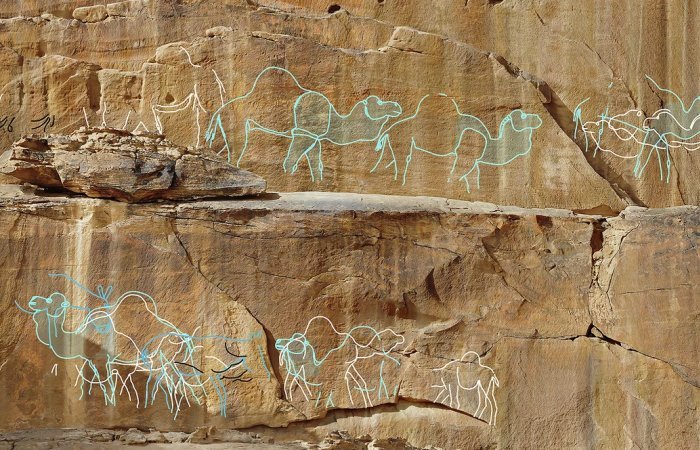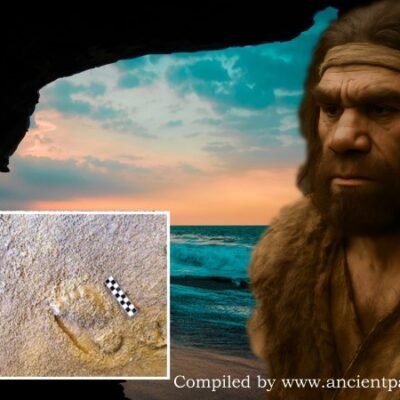Jan Bartek – AncientPages.com – A research team has discovered over 60 rock art panels featuring 176 engravings in three previously unexplored regions—Jebel Arnaan, Jebel Mleiha, and Jebel Misma—located along the southern edge of the Nefud Desert in northern Saudi Arabia. These engravings primarily depict camels, ibex, equids, gazelles, and aurochs.
Studied rock art panels. A human figure was added on the far left for scale (1.7 m). Credit: Guagnin, M., Shipton, C., Al-Jibreen, F. et al.
Among them are 130 life-sized, naturalistic figures, some measuring up to 3 meters in length and exceeding 2 meters in height. Sediment analysis has confirmed that these areas once had water sources that supported early human migrations into the desert interior by providing rare survival opportunities.
In a recent study, researchers highlight new findings that underscore the pioneering role of human groups inhabiting northern Arabia’s interior shortly after the hyper-arid conditions of the Last Glacial Maximum (LGM). These groups were guided by the return of seasonal water sources and left behind a significant legacy through their rock art.
“These large engravings are not just rock art—they were probably statements of presence, access, and cultural identity,” said lead author, Dr. Maria Guagnin from Max Planck Institute of Geoanthropology.
Monumental rock art illustrates that humans thrived in the Arabian Desert during the Pleistocene-Holocene transition. Credit: Guagnin, M., Shipton, C., Al-Jibreen, F. et al.
Dr. Ceri Shipton, a co-lead author from the Institute of Archaeology at University College London, highlighted that the rock art serves as markers for water sources and movement routes, potentially indicating territorial rights and preserving intergenerational memory.
Unlike other sites where engravings were discreetly placed in crevices, the panels at Jebel Mleiha and Jebel Arnaan are prominently etched onto towering cliff faces, some reaching heights of up to 39 meters.
This strategic placement in visually commanding locations suggests their importance. Creating one panel required ancient artists to climb and work on narrow ledges, emphasizing both the effort involved and the significance of these images.
Rock art panels at Jebel Arnaan. Credit: Maria Guagnin
Artifacts found at these sites include Levantine-style El Khiam and Helwan stone points, green pigment, and dentalium beads—indicating connections with Pre-Pottery Neolithic populations in the Levant region. Nevertheless, the Arabian engravings distinguish themselves through their scale, content, and unique placement.
“This unique form of symbolic expression belongs to a distinct cultural identity adapted to life in a challenging, arid environment,” said Dr. Faisal Al-Jibreen, from the Heritage Commission, Saudi Ministry of Culture.
See also: More Archaeology News
“The project’s interdisciplinary approach has begun to fill a critical gap in the archaeological record of northern Arabia between the LGM and the Holocene, shedding light on the resilience and innovation of early desert communities,” said Michael Petraglia, lead of the Green Arabia project.
The study was published in the journal Nature
Written by Jan Bartek – AncientPages.com Staff Writer








